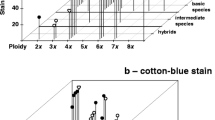Abstract
The pollen fertility and seed formation of six species of theOrnithogalum umbellatum/angustifolium complex and of seven related species were studied. Four types of pollen grains could be recognized. The pollen fertility varied greatly in this complex and is not related to the ploidy level. The seed formation ofO. umbellatum showed an adaptation to a subcontinental-Mediterranean climate, that ofO. angustifolium to an Atlantic climate. In both cases raindrops seem to be important for pollination, in view of the absence of insect pollinators. After open pollination 113 seedlings were obtained in four species. Their chromosome numbers were determined. Nearly all the cultivated seedlings were aneuploid, which points to a positive selection of euploids in nature, because aneuploid individuals are rare in the wild.
Similar content being viewed by others
References
Czapik, R., 1965: Karyotype analysis ofO. umbellatum L. andO. gussonei Ten. — Acta Biol. Cracov., Bot. series8, 21–36.
—, 1966: The mechanisms of cytological differentiation in triploid populations ofOrnithogalum umbellatum L. — Acta Biol. Cracov., Bot. series9, 65–86.
Gadella, Th. W. J., 1977: DiploidRanunculus ficaria L. in the Netherlands. — Proceedings Roy. Neth. Acad. Sci.80(2), 80–82.
—, 1982: Cytology and reproduction ofHieracium pilosella L. and some related diploid species. — Acta Bot. Neerl.31(1/2), 140–141.
—, 1981: Biosystematic studies onOrnithogalum umbellatum L. s.l. — Bol. Soc. Brot.53, 745–791.
Gustaffson, A., 1946: Apomixis in higher plants. Part I. The mechanisms of apomixis. — Lunds Univ. Arsskr. N.F. Adv. 2,42(3), 1–67.
Law, R., Cook, R. E. D., Manlove, R. J., 1983: The ecology of flower and bulbil production inPolygonum viviparum. — Nord. J. Bot.3(5), 559–565.
Neves, J. de B., 1952: Estudios cariologicos no generoOrnithogalum L. — Bol. Soc. Brot.26, 1–93.
Raamsdonk, L. W. D. van, 1985: Biosystematic studies on theumbellatumangustifolium complex in the genusOrnithogalum L. II. Genome characterization and evolution. — Nord. J. Bot., submitted.
Tornadore, N., Garbari, F., 1979: Il genere “Ornithogalum” (Liliaceae) in Italia. 3. Contributo alle revisione citotassonomica. — Webbia33(2), 379–423.
Author information
Authors and Affiliations
Additional information
Biosystematic Studies on theOrnithogalum umbellatum/angustifolium Complex III.—Previous parts of this series are Part I: Taxonomy. Proceeding Kon. Ned. Acad. Wet. series C,85 (4), 563–574 (1982) andvan Raamsdonk (1984).
Rights and permissions
About this article
Cite this article
van Raamsdonk, L.W.D. Pollenfertility and seed formation in theOrnithogalum umbellatum/angustifolium complex (Liliaceae/Scilloideae). Pl Syst Evol 149, 287–297 (1985). https://doi.org/10.1007/BF00983312
Received:
Issue Date:
DOI: https://doi.org/10.1007/BF00983312




